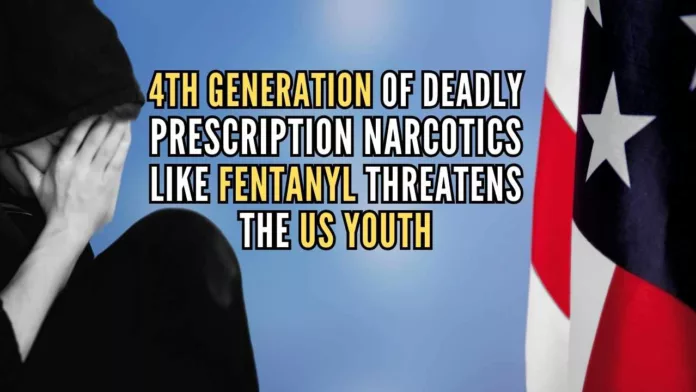
The 2024 US Presidential Elections may see War on Drugs as a talking point
War on Drugs could quickly become one of the talking points of the 2024 US Presidential Elections. As opioids enter a synthetic (meaning grown in labs – a la Breaking Bad), it risks wiping out an entire generation. What is the United States doing about it? Does this ever enter the agenda of the countless meetings the Biden Administration holds with its counterparts in China?
A History of Opium
Over time, Opium has evolved and it can be broadly categorized as follows[1]:
Opium Derivatives
Non-synthetic (naturally occurring)
1. Morphine (Bayer) 1850s.
2. Codeine (Roche) 1880s.
Synthetic Derivatives (chemical synthesis)
3. Oxycodone (Purdue Pharma) 1990s.
4. Fentanyl (Jansen J&J) 1960s.[2]
Pop Quiz: What was the cause of the death of Robert Clive, the unscrupulous and uncouth architect of the British East India Company?
Ans: Opium Addiction!
Fentanyl & opioids
Drugs overdose causes 125,000 deaths per year in the USA.[3]
What is Fentanyl?
Fentanyl is a potent synthetic opioid drug approved by the Food and Drug Administration for use as an analgesic (pain relief) and anesthetic. It is approximately 100 times more potent than morphine and 50 times more potent than heroin as an analgesic.[4]
What are its origins?
Fentanyl was first developed in 1959 and introduced in the 1960s as an intravenous anesthetic. It is legally manufactured and distributed in the United States. Fentanyl is a Schedule II narcotic under the United States Controlled Substances Act of 1970. Licit fentanyl pharmaceutical products are diverted via theft, fraudulent prescriptions, and illicit distribution by patients, physicians, and pharmacists.
According to the Centers for Disease Control and Prevention (CDC), fentanyl analogues were involved in roughly 2,600 drug overdose deaths each year in 2011 and 2012, but from 2012 through 2018, the number of drug overdose deaths involving fentanyl and other synthetic opioid increased dramatically each year. More recently, there has been a re-emergence of trafficking, distribution, and abuse of illicitly produced fentanyl and fentanyl analogues with an associated dramatic increase in overdose fatalities, ranging from 2,666 in 2011 to 31,335 in 2018 (projected 100K in 2022.).
Lethal Dose: 2 milligrams (2 thousandths of a gram) leads to death in an adult.
Fentanyl pharmaceutical products are currently available in the following dosage forms: oral transmucosal lozenges commonly referred to as fentanyl “lollipops” (Actiq®), effervescent buccal tablets (Fentora®), sublingual tablets (Abstral®), sublingual sprays (Subsys®), nasal sprays (Lazanda®), transdermal patches (Duragesic®), and injectable formulations.
History of Fentanyl
The company Janssen Pharmaceutica first developed fentanyl in 1959. Then, it was primarily used as an anesthetic and pain reliever for medical purposes.
During the 1960s, fentanyl started to be used as an intravenous anesthetic called Sublimaze. It wasn’t until the mid-1990s that the fentanyl patch was introduced and could be used in the treatment of chronic pain.
After the introduction of the patch, other ways of delivering fentanyl were introduced, like the Actiq lollipop.
Where does Fentanyl come from?
Where does fentanyl come from, in regards to illicit use? Most fentanyl in the United States comes from China. China isn’t where fentanyl originated, but because of the lack of regulations in the pharmaceutical industry there, the country is a large distributor of drugs and chemicals that are illegal in other countries.[5]
China exports many different types of fentanyl products, including raw fentanyl, fentanyl analogs, and counterfeit prescription drugs like oxycodone that are laced with fentanyl.[6]
While some fentanyl comes directly from China, many other Chinese shipments of fentanyl will enter the United States through Mexico. Fentanyl may come through Canada before entering the United States, though it is uncommon.
There are different ways smugglers get fentanyl into the United States. In 2015, United States border agents seized approximately 200 pounds of fentanyl among other synthetic opioids. In comparison, in 2014 they seized around 8 pounds.
China has shown interest in preventing fentanyl from being exported from their country illegally. There was also a piece of legislation signed into law in October 2018 in the United States called the Synthetics Trafficking & Overdose Prevention Act. Despite these efforts, fentanyl remains one of the most problematic opioids in the United States.
New threat warning from Federal agencies DEA and FDA
The U.S. Drug Enforcement Administration is warning the American public of a sharp increase in the trafficking of fentanyl mixed with xylazine[7]. Xylazine, also known as “Tranq,” is a powerful sedative that the U.S. Food and Drug Administration has approved for veterinary use.[8]
There are no approved uses of xylazine for humans. FDA is aware that xylazine is increasingly detected in the illicit drug supply and in drug overdoses[9]; however, individuals who use illicit drugs may not be aware of xylazine’s presence in their supply. Xylazine has primarily been identified in combination with heroin and fentanyl. Stimulants (e.g., methamphetamine and cocaine) have also been combined with xylazine.
Reference:
[1] Opioid Crisis – HRSA
[2] Controlled Substances – by CSA Schedule – USDOJ.gov
[3] Drug Overdose Deaths in the U.S. Top 100,000 Annually – Nov 17, 2021, USDOJ.gov
[4] Drugs Fact Sheet – Fentanyl – DEA.gov
[5] China’s deadliest export to America: fentanyl – Dec 09, 2018, USA Today
[6] Fentanyl: China’s Deadly Export to the United States – Feb 01, 2017, USCC.gov
[7] Justice Department Announces Global Resolution of Criminal and Civil Investigations with Opioid Manufacturer Purdue Pharma and Civil Settlement with Members of the Sackler Family – Oct 21, 2021, HHS.gov
[8] DEA Reports Widespread Threat of Fentanyl Mixed with Xylazine – DEA.gov
[9] Inspections, Compliance, Enforcement, and Criminal Investigations – FDA.gov
PGurus is now on Telegram. Click here to join our channel and stay updated with all the latest news and views
For all the latest updates, download PGurus App.
- Supreme Court rejects plea to tally all VVPAT slips with EVM votes; says ‘no going back to paper ballot’ - April 26, 2024
- US report citing human rights violations is deeply biased: India - April 25, 2024
- Kotak Mahindra Bank shares tank 13%. Market Cap erodes by Rs.37,721 cr post-RBI action - April 25, 2024










